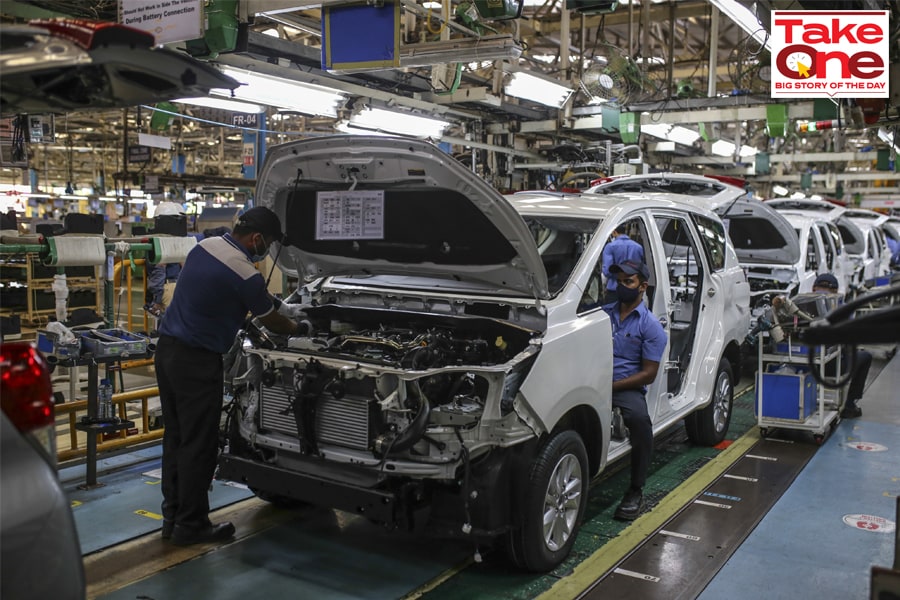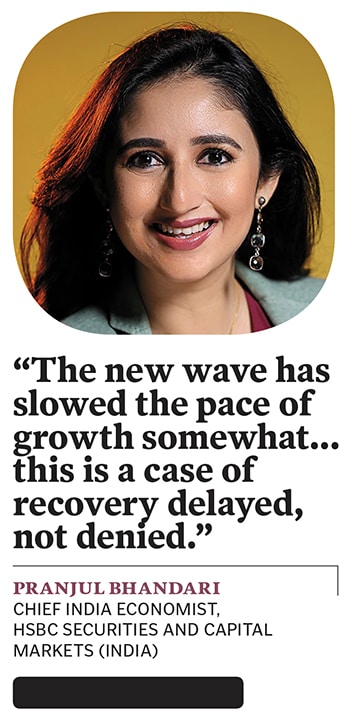It has gone south in a matter of just a few weeks. And it could go down even further.
In early February this year, India’s Covid-19 situation was the case of envy for many. The country had brought down its daily cases to less than 10,000 cases a day, from about 97,000 cases in September last year. Considering the large swathes of population, the dip in numbers was an exceptional achievement, and came amidst the rollout of the world’s largest Covid-19 vaccination program.
The International Monetary Fund (IMF) revised its growth forecast for Indian economy to 11.5 percent in 2021, making it the only major economy expected to register a double-digit growth amidst the pandemic. Finally, after months of restrictions and uneasiness, life was finally limping back to normalcy. But eight weeks since then, and over a year since the country into a nationwide lockdown to curb the country’s Covid-19 cases, that had scourged the country’s economy and put its healthcare sector in disarray, a second wave has fast come to Indian shores.
And this time around, it is worse than the past one. On April 5, Covid-19 cases in the country crossed 100,000 cases for the first time, with Maharashtra alone accounting for half of those cases. Much of the rapid rise in cases, this time around, is also attributed to newer mutations of the original virus. While mutations are quite common, the Indian double variant has been categorised as a variant of concern” (VOC) and is now being closely monitored.
“Although the exact contribution of mutant strains to the escalation of cases in some states remains speculative, the measures to control the pandemic remain the same and hence implementation of various protocols for Covid-19 management are all the more critical in those areas,” a statement from the prime minister’s office said.
![anil rai gupta anil rai gupta]()
On April 5, India’s benchmark index, the Sensex slipped as much as 1,100 points largely due to uncertainty about India’s Covid-19 situation, and particularly since state governments began enforcing lockdown within their jurisdiction. The country’s financial capital, Mumbai has put serious restrictions including night curfews and a full lockdown on weekends. Many other states and cities have also begun to put restrictions including Karnataka and Tamil Nadu.
“It was emphasised that the reasons for the sharper rise in cases could be mainly attributed to the severe decline in compliance of Covid-appropriate behaviour primarily in terms of use of masks and maintaining "2 Gaj ki Doori", pandemic fatigue and lack of effective implementation of containment measures at the field level,” a statement from Narendra Modi’s office said on April 4.
Last year, as Covid-19 cases began to surge, India had announced a strict nationwide lockdown, that lasted nearly two months before relaxations were brought in. But, that didn’t stop the economy from going through its worst phase in four decades before embarking on a remarkable recovery. The country’s Gross domestic product (GDP) grew 0.4 percent in October-December 2020 compared with the same period a year earlier, after contractions of 7.3 percent in July-September and 24.4 percent in April-June. Investments too had recorded its first growth since December 2019, growing at 2.6 percent during the third quarter of the previous financial year.
Now, that dream run seems to be running into some trouble. In February, the output of eight core infrastructure sector contracted by 4.6 percent according to the government. "The combined Index of eight core industries stood at 127.8 in February 2021, which declined by 4.6 (provisional) percent as compared to the index of February 2020," the ministry of commerce and industry said in an official release.
“The second wave in coronavirus infections has not yet destabilised India’s economic recovery,” Anil Rai Gupta, the chairman and manging director of Havells India, a consumer durable major told Forbes India. “But the proliferating localised lockdown, like in the state of Maharashtra, can have an impact on the economic growth in the April-June quarter. However, we have observed a steep pent-up goods demand that led the economic recovery previous quarter and is expected to be a key driver going forward. Hence this can be a case of a delayed economic recovery.”
Between April 2020 and February, industrial output fell by 8.3 percent across sectors such as coal, crude oil, natural gas, and refinery products. Factory activity too slowed to a seven-month low and saw its weakest pace in seven months.
“It is a disturbing and alarming situation,” Naveen Soni, the senior vice president for sales and marketing at automaker, Toyota Kirloskar Motors says. “But, having gone through the crisis last year, and learning from the situation, we are better prepared to deal with the situation. If the situation worsens, we will definitely see a softening of the demand, but it won’t be uniform with what we saw during the first wave.”
Hospitality, FMCG, Auto to be Hit
Yet, the sudden spurt in cases may has certainly thrown away some of the gains made in the past few months.
"Even if the lockdowns are not localised, they affect supply chains,” Pronab Sen, the former chief statistician of India says. "The dominant effect in the services sector is fear. As of now the fear factor doesn’t seem to be very large but the question is when does that (fear) come back (and people stop going out)."
For instance, in travel, which has been amongst the worst hit sectors in the country, a recovery now seems rather prolonged. After India allowed airlines in the country to fly in May 2020, after the lockdown, airlines had been operating at 80 percent capacity.
![riyaaz amlani riyaaz amlani]()
“The second wave of Covid-19 is definitely having a knock-on impact and we do foresee a transitory slump in travel bookings in the near-future,” a spokesperson for MakeMyTrip told Forbes India. “Latest booking patterns on MakeMyTrip indicate that while travellers are willing to postpone their upcoming vacation by a few weeks as they monitor the situation, they are still keen taking a summer holiday with more caution. While there is an understandable dip in leisure travel sentiment as uncertainty around the virus returns, a faster vaccine rollout should also have a bearing on overall sentiment in the coming weeks.”
The second wave comes at a time when India has decided to make all its citizens aged above 45 eligible for vaccinations. So far, since the programme began on January 16, vaccines were only provided to those on the frontlines before it was extended to those above 60 years. On March 1, those above the age of 45, but with co-morbidities, were also allowed to vaccinate themselves. India has approved the use of Covishield, commonly known as the AstraZeneca vaccine, and the indigenous Covaxin, developed by Hyderabad-based Bharat Biotech, currently to vaccinate its people.
So far, some 76 million doses of vaccines have been administered, according to the government, of which 9.5 million people have completed both the first and second dose. That’s only about 0.7 percent of the Indian population of 1.35 billion people. Additionally, some 67 million people have received the first dose so far. That number is in stark contrast to what the Indian government had initially set out to achieve by July when India began the vaccination programme. The country is looking to vaccinate between 200 million and 250 million people by July 2021, four months from now.
"The hospitality industry had started seeing a recovery, we had reached almost a 65 percent to 70 percent of our pre-Covid levels,” Riyaaz Amlani, CEO, Impresario Entertainment & Hospitality Pvt. Ltd told Forbes India. “The customer sentiment was back and now the recent lockdown is going to decimate the restaurant industry. I"m not holding the government responsible, but like international governments, ours too needs to compensate and pay salaries to our employees and keep this sector—one of the largest employers and one of the hardest hit—afloat. The least it can do is defer our excise duties and utility bills and offer rebates."
Currently, eight states account for about 80 percent of the cases, a number that is only expected to swell in the coming days. The central government has also identified urban clusters including Delhi, Mumbai and Bengaluru, as a cause of concern in the weeks ahead.
The worries have been corroborated by India’s largest bank, the State Bank of India (SBI), which has said in a recent report that India is witnessing a second wave beginning February 2021. “Considering the number of days from the current level of daily new cases to the peak level during the first wave, India might reach the peak in the second half of April,” says SBI in the report published on March 25. “The entire duration of the 2nd wave might last up to 100 days counted from 15th February.” That could very well mean the crisis isn’t likely to end before May.
That has also meant that companies have returned to their playbook from last year to navigate through the ongoing crisis. “While the buying sentiment has turned shaky in some markets that are highly impacted by the current spate of lockdowns, we are applying learnings from last year on streamlining the supply Chain to ensure minimal disruption in supplies,” Adarsh Sharma, executive director (sales) at Dabur India says. “Some of the measures implemented last year, like order-booking though our call centre and WhatsApp, continue to function and have, in fact, been stepped up. In addition, we have increased frequency of supplies to distributors and outlets in the impacted markets to tide over any potential impact.”
Even manufacturing, which had seen a rebound soon after the lockdown has now seen a decline. In fact, according to the latest data available, growth in manufacturing slowed to the lowest rate in seven months, as increasing Covid-19 cases hit demand, said IHS Markit’s purchasing managers" index (PMI) on Monday.
![pranjul bhandarib pranjul bhandarib]()
PMI fell from 57.5 in February to a seven-month low of 55.4 in March. “Employment declined in March, taking the current sequence of job shedding to a year,” IHS Markit said in a statement on April 5. “The rate of contraction was modest, but the quickest since September 2020. Panellists indicated that the fall stemmed from Covid-19 restrictions related to workforces. Despite the reduction in payroll numbers, outstanding business rose only marginally.”
Much of that is also due to a slowdown creeping into business, as cases in the country rise. “Business confidence waned in March,” the report added. “While some firms foresee output growth in the coming 12 months, the vast majority predicted no change from present levels. Where optimism was signalled, this was commonly pinned on hopes that Covid-19 controls would ease.”
That, however, may not happen anytime soon. “The new wave has slowed the pace of growth somewhat (although recovery is already at pre-pandemic levels),” Pranjul Bhandari, chief India economist at HSBC Securities and Capital Markets (India) says. “It is now likely that the services-led rebound will be realised in its entirety in 2HFY22 instead of 1H. In that sense, this is a case of recovery delayed, not denied. In fact, the GDP growth numbers in FY22 will now be more uniformly spread. Earlier 1H was benefitting from both low base effects and pent-up services demand. Now base effects are likely to support 1H, and pent-up demand saved for 2H.”
So what happens now?
Already in Mumbai, a state government notification said that all shops except essential services would remain shut till the end of the month. Restaurants will be allowed to operate only takeaway and home delivery services during the day hours while theatres, cinema halls, malls, gardens and playgrounds were to remain closed. While night curfew will be imposed every day from 8pm to 7am, gatherings of five or more persons will be prohibited during the daytime.
According to the Google Mobility report, a database that shows how visits to places, such as corner shops and parks, are changing in each geographic region, India has been seeing a decline in visits to workplaces, recreational facilities and parks between February 17 and March 31. Mobility trends for places such as restaurants, cafés, shopping centres, theme parks, museums, libraries and cinemas have fallen 22 percent while mobility trends for places of work have fallen 16 percent.
For now however, there are expectations that the economy might just be able to withstand the ongoing crisis. “The fear factor has disappeared,” VR Sharma, managing director at JSPL, one of the country’s largest steel manufacturers. “We have learnt how to deal with the situation and there is an adequate stock of vaccine, which will help improve vaccination program. Demand is certainly no going to be affected, and things will improve soon.”
On April 5, India’s finance ministry said that the country is more resilient and better poised to deal with the second wave of Covid-19 pandemic. "At this juncture of onset of second wave, India is well prepared to combat the scourge of the virus,” the Finance Ministry"s Department of Economic Affairs said in its monthly economic report for March. “It is well-equipped with adequate testing and health infrastructure and economic activity has adapted to the pandemic. This prospect is, further, bolstered by the fast roll-out of vaccination.”
India is still vaccinating at less than 2 million doses a day across its 44,500 centres. A total of 75 million registrations have been received so far for vaccinations. On April 4, 1.5 million doses were administered, down from the high of 3 million on March 22.
"The growth impact of the fresh lockdowns will be localised and very small compared to those seen in 2020,” Rahul Bajoria, chief India economist at Barclays. “The co-relation between economic activity and Covid cases has slipped. Covid cases have been increasing due to the rise in mobility. More economic activity will drive more Covid cases. But it still does not move the needle for me to change the growth outlook." Barclays has revised India"s GDP forecast for FY22 to 11 percent from an 8.5 percent projected earlier.
India, Bajoria says, is ahead of Barclays own vaccination drive targets. “We had assumed India to have 67 million vaccinated as of yesterday as per our vaccination tracker, compared to 79 million actually vaccinated, based on the MoHFW [Ministry of Health and Family Welfare] data. Based on our projections, the vaccination run-rate appears satisfactory given vaccine supply constraints.”
The pressure on the hospital capacity utilisation—and any further rise in the death rates—in states like Maharashtra will be critical, to decide on the impact of the pandemic and how people and the government will behave in coming months.
"We always knew that will not have the smooth road towards a 12-14 percent growth for FY22."
(With additional reporting from Salil Panchal, Samar Srivastava, Rucha Sharma and Anubhuti Matta)




